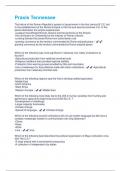Exam (elaborations)
Praxis Tennessee Questions & Answers Already Graded A+
- Course
- Institution
The failure of the Roman Republic's system of government in the first century B.C.E. led to the establishment of the Roman Empire in the first and second centuries C.E. In the period described, the empire experienced -a plague that afflicted Roman citizens and the territories of the Empire -the...
[Show more]



